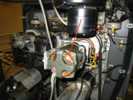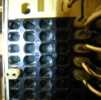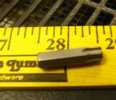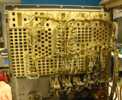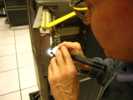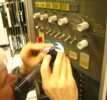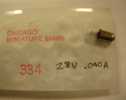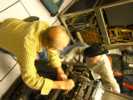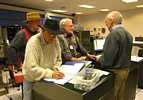Schedule December 2008
return to main 1401 Restoration Page
go to Team Bios
Contents:
Wed December 03 - general
John check his schedule on one of those mysterious pocket things, and promised to
show us the planning displays of the coming formal museum next Wednesday, very early afternoon.
Bill,
The only solution Ed and I came up with is that aliens did the actual printing.
Stan
Thursday December 04 - Tape Team
[ an internal comment ]
Regards,
Wednesday December 10 - General
Jóhann's comments, above, seem good to me:
Tungsten resistivity is 52.8 Ωm at 20 °C, however as temperature increases, also does resistivity.
TUNGSTEN RESISTANCE VS TEMPERATURE
Thursday December 11 - Tape Team
from Sam Sjogren, Dec 12
Saturday December 13 - 2nd Saturday
Wednesday December 17 - General
Thursday December 18 - Tape Team
Please note. I will not be coming to ’’work’ ’on Wednesday since all mechanical work is finished and now ‘read/write’ debug which is best done on Thursday with emulator team.
I do ask that from now on nobody try to fix any problems that come up either drive. Just either call me/send an email or leave a note on the machine and I will fit it when I come in. Reason is that I want to have one-person maintain the drives from here on until we have them running perfectly.
allen
Saturday December 27 - 4th Saturday
Bob brought in a Teletype ASR 33 like mine. It belonged to his neighbor. I spent some time on it and got most of it working. He also brought in several, never been used, ribbons for the TTY. They are dry.
We have at least a dozen rolls of paper tape and 5 boxes of fan fold paper tape which I gave to Mike. His PDP1 uses that stuff.
The CT machine is really acting funny. Put the machine in Alter and store a byte and the printer prints a line of that byte. (byte = BCD character) That byte is not in the print buffer.
I am not sure, but I think the machine had a stroke coming from the East coast to California.
There is a possibility that the problems with the printer and the card reader may be related.
Of course, there is a possibility that Elvis is still alive.
Bill Worthington and I ran my simple tape test of 729
#1 of the DE 1401.
As in the last try, the error count was appraching 50%.
Bill said "Have you tried a new tape?"
We took a tape from the back rack and put it on.
I am headed for Carson City in the morning. I will be back in the shop on Wed the 7th, the good lord willing.
Have a happy new-year.
Stan
Wed Dec 3 - General, Thurs Dec 4 - tape team
Wed Dec 10 - General,
1401RFI-Music, Thurs Dec 11 - tape team, Sat Dec 13 - 4th Sat
Wed Dec 17 - General, Thurs Dec 18 - tape team
Merry Christmas :-)) , Sat Dec 27 - 4th Sat
John seemed very interested and sympathetic to making the mysterious explainable by
means of showing data cards and card operations like sorting, merging, adding, printing, ...
and how easy and interesting say electric billing is:
no great mystery when you can *SEE* the data and operations
but then the mystery started, what is going on in there?
Stan wrote a little program to print the 1st line once, the second line impacted twice, the third 3 times, ...

click for normal size,
click for expanded size
Life got interesting trying to explain those round dots in/near the characters. If they are caused by the ribbon,
the ribbon moves vertically - should be different dots each separate impact !?! therefore more dots for more impacts.We are open to comments.
A day later, Stan forwarded the one resulting font. Two other font
images were included, one "heavy", and one "light".
Much ado about nothing.
I've always felt that letters were to communicate with - and that the upper case only 1403 FORTRAN font was
just fine for everything - just kidding, I think.
A few days later, after some lively discussion, Stan sent to the commenting multitude -
Ed and I had this discussion earlier in the week.
The sample I sent jay had 5 lines. Line 1 had single ; Line 2 double print....;Line 5 was hit 5 times.
Even line 5 had distinct dots. Since the ribbon was moving, the highs and lows of the ribbon would not be the same each time.
But the highs and lows of the paper would. (maybe)
from Bob Feretich
TAU Debug Status - 12/4/08 (Jeff S., Sam S., and me)
We last worked on the CT system 3 weeks ago. The "Skew Error" problem
that we saw then was back today. We traced the error to the Emulator.
It was dropping "Ready" too early. I don't know why we didn't see this
problem on the German system. We delayed the drop by 400 uSec and the
error disappeared.
CT System Status:
Bob Feretich
Kirsten Tashev and Dag Spicer of the museum staff smiled as they came to visit us. The timing was
fortunate - everyone was looking busy!!
I told them that we are just like puppy dogs, we like to have our heads patted.
(Added Dec 22) - Jóhann Gunnarsson,  of Icelandic
"IBM 1401: A User's Manual" music fame, has identified the tune as
"Wheels". He e-mails " It can be found in various versions on Youtube, for instance performed by Chet Atkins:
http://www.youtube.com/watch?v=YzL4ntNwpH8&feature=related"..
of Icelandic
"IBM 1401: A User's Manual" music fame, has identified the tune as
"Wheels". He e-mails " It can be found in various versions on Youtube, for instance performed by Chet Atkins:
http://www.youtube.com/watch?v=YzL4ntNwpH8&feature=related"..
(Added Dec 23)
I appealed for help
"Unfortunately I don't know how to give it a good category
One can say "1403 Chain Printer Music"
But the best I can come up with for music generated by
Radio Frequency Interference
from a 1401 is
"1401 RFI Music"
which is an even a less lovely name than "Chain Printer Music"
The whole field of "computer music" seems to beg for more descriptive names:
- computer composed tunes
- audible music caused by actions of a computer by
- printers of various kinds
- a loud speaker connected to various parts of a computer circuit
- Radio Frequency Interference
- and probably many categories I have forgotten"
Jóhann Gunnarsson responded with:
"Regarding descriptive names for this kind of music, I have always connected it with the magnetic core memory. The music pattern, pitch and length of notes is after all controlled by what is going on in the memory.
"If I remember correctly, in order to get best results we used to put the AM radio right on top of the memory module. I vaguely remember that we could hear RFI noise from the IBM 1620 as well, although we never really tried to find out how to play it.
"In my opinion, 'IBM 1401 memory music' is quite a descriptive name for this phenomenon."
Ron Crane reminds me of C.T. Winter at General Electric Computer. Charlie never hurried,
was never slow, (like a bull dozer driven by a pro.) He analyzed carefully and thoroughly,
any changes documented carefully and completely,
and when he fixed something, you had confidence it was better than new and
could never be troublesome again!
The panel lamps of "our" 1401s have never worked visually well. Some adequately bright, some faint, and some
you cocked your head, squinted at, and more or less said it looked ON (or OFF). And some of the control buttons were
not back lit at all - giving a ragged appearance.
Ron Crane apparently decided to "Make Them Right".
Some of the problems he found included:
Unfortunately, the current production of this lamp, especially from "off-shore" is a few thousandths
over size - sometimes making a too snug fit in the plastic two part holders, especially if mis-aligned or
incompletely de-burred.
Ron made this document clarifying the correct lamp to use for the indicator bulbs.

And a picture of the correct lamp. (The reamer at the bottom will be discussed below.

The incorrect replacement bulbs were slightly undersized, and fit well into the German (DE)
1401 lamp holders.
R/R
300
Temperature
(K)
R/R300
Temperature
(K)
R/R300
Temperature
(K)
1.00 300 7.14 1500 14.34 2700
1.43 400 7.71 1600 14.99 2800
1.87 500 8.28 1700 15.63 2900
2.34 600 8.86 1800 16.29 3000
2.85 700 9.44 1900 16.95 3000
3.36 800 10.03 2000 17.62 3000
3.88 900 10.63 2100 18.28 3000
4.41 1000 11.24 2200 18.97 3000
4.95 1100 11.84 2300 19.66 3000
5.48 1200 12.46 2400 20.35 3000
6.03 1300 13.08 2500 - -
6.58 1400 13.72 2600 - -
R300 -Resistance of tungsten filament at room temperature
R -Resistance of tungsten filament when hot.
Temperature -average temperature of filament. There are hot spots near the middle and cool spots near the support leads.
Using the resistivity ratio above gives the temperature of the filament, which gives spectoral info.
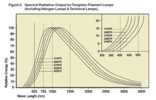
from http://www.squidoo.com/tungstenlamps
Using percent rated voltage,
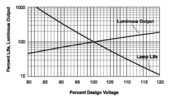
Output vs. life
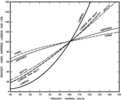
output vs. watts
from
http://www.sylvaniaautocatalog.com/new_sylvania/vwd_justso.htm.
Ron has a catalog giving the illumination out of a 1/4 inch hole in front of the lamp.
There are three common filament configurations - the best for illumination
as indicators being the "v" configuration a plane parallel to the front panel
Wednesday from Allen Palmer
worked on German #1 … problem was failing to go into hi-speed rewind. Found that there is a thermo-interlock in the circuit. Took awhile where it was, it is on the outside of the hi-speed motor against the windings. Removed the motor but there is no way to replace the switch. Tapped the switch capsule ‘gently’ with a hammer and the bi-metal strips released. Reinstalled motor and hi-speed rewind function now working again. Ed has a picture to add to the report.
TAU Debug Status - 12/11/08 (Jeff .S, Sam S., Ron C., and me)
We fixed a bug in our Autocoder tape copy program that was writing
accidentally very very long records.
We troubleshot the I-STAR load bug. (The "Load Tape" button was not
loading it.)
It turned out that just bit 4 in the hundreds digit was not getting
reset. We replaced that STAR card and the problem went away.
We were then able to reliably run the below scenario:
The CT 1401's tape subsystem is now "mostly working". There are several
things that we haven't checked out yet (odd parity, backspace, etc.),
but there are diagnostic decks to test these functions and it would be
inefficient to try to check these functions out without a working card
reader and printer. So, we are going to turn our attention to improving
the stability features of the emulator.
Emulator bugs and enhancements:
The other operator controls need further testing (tape density controls
and tape indicator status).
We also want the Emulator to work via wireless intranet from a
student's notebook computer. We were able to run the Emulator today
wirelessly from my notebook computer, but it would be easier if certain
changes were made. Jeff will publish a request for CHM IT actions to
simplify this connection.
Regards,
Bob Feretich
Bob forgot to mention the successful testing of the new optical interface between the tape emulator and the 1401. Photos attached.
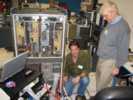
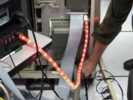
Tuesday - These are some of Ron Williams' pictures - scanned by Stan Paddock -
here for
the start of the action.
This is the card path, minus the read and check read brushes, in the CT 1402 card reader.
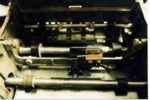
This is the "before" picture of the 14 thousandths concavity of a roller.
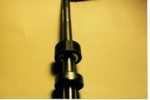
Ron took the roller home, heated it to 200 F. for three hours. It swelled up 20 thousandths of an inch.
(Conavity 26 thousandths) Here is the roller in the lathe -
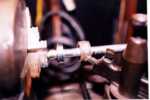
to have the expanded material removed, leaving a cylindrical roller of original dimensions.
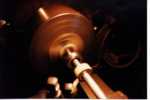
And here is the "after" picture.
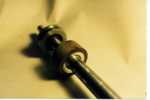
Apparently the cards moved more smoothly and remained better in line after this roller treatment.
But - now there are apparently electrical or logical problems preventing proper card reading using the CT machine.
from Bob Feretich
Thursday from Allen Palmer
Worked on the German #2 drive.
[ from Stan Paddock ]
Ron Williams, Bob Erickson and his son Dean, Bill Worthington and Mike Cephonis all came in today.
The answer was no.
Out of 8000 records, 14 recorded an error. .175 %
It appears that the DE #1 79 is ok.
Go to January 2009
go to Team Bios
